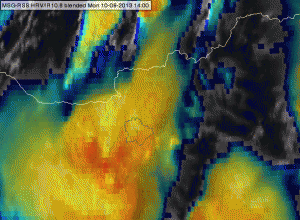The joint EUMETSAT-ESSL Convection Working Group has met from 7 – 11 April in Zagreb to review the state-of-the-art in the use of satellite data for the detection and prediction of convective storms. Over 40 participants from Europe and around the world presented and discussed their research. The workshop dealt with techniques that assess the preconvective environment, to detect the development of storms and to monitor mature stages of their life cycle. In addition, ways to combining satellite information with other data were discussed. The use of satellite imagery with a very high temporal resolution, such as that obtained in the 2013 experiments with 2.5-minute scans, received particular attention.
Download the Minutes of the Workshop by clicking here.
These are the presentations of the meeting:
Session 1: Pre-convective environment
- Marianne König: GII and forecast background fields [pdf].
- Mária Putsay: Satellite derived instability indices – some further insights (part I) [pdf].
- Zsófia Kocsis: Satellite derived instability indices – some further insights (part II) [pdf]
- Ralph Petersen: Diagnosing and predicting the pre-convective environment on 20 June 2013 [ppsx]
- Izidor Pelajić: Preliminary results on using hyperspectral data in stability analyses [pdf]
- Daniel Rosenfeld: Use of satellite measurements of surface skin temperature for retrieving the intensity of thermals [pdf]
- Sung-Rae Chung: Development of Instability Index of GEO-KOMPSAT-2A [ppsx]
[movie; avi] - José Miguel Fernández-Serdán: Brief introduction to a tool upgrade [pdf]
- Ralph Petersen: Lessons learned at the ESSL summer experiment regarding current and future observations and predictions of the pre-convective moisture structures [ppsx]
- Thomas Krennert: Symmetric instabilities in DMC initiation [pdf]
Session 2: Early Convection
- Daniel Rosenfeld: Use of high-resolution NPP/VIIRS imager for retrieving cloud base temperature and application for estimating boundary layer vapour mixing ratio [pdf]
- Danyu Qin: CMA rapid development convective clusters algorithm for FY-4 [pdf]
- Yasuhiko Sumida: Efforts of upgrading Rapidly Developing Cumulus Area product using NWP data and the satellite simulator [ppsx]
Session 3: Mature Convective Clouds
- Pao Wang: Dynamical processes at the storm top [ppsx]
[movie 1; avi] [movie 2; avi] [movie 3; avi] [movie 4; avi] [movie 5; mp4] - Daniel Rosenfeld: Using MSG retrieved cloud parameters for nowcasting of severe convective storms [pdf]
- Jochen Kerkmann: Case study of cold ring-shaped storm [ppsx]
[movie 1; mp4] [movie 2; mp4] - Jochen Grandell: Status of LI proxy data [ppsx]
[movie 1; avi] [movie 2; avi] [movie 3; avi] [movie 4; avi] [movie 5; avi] [movie 6; avi] [movie 7; avi] [movie 8; avi] - Luiz Machado: Nowcasting the fortracc and lightning – the CHUVA campaign [pdf]
- Mateja Iršič Žibert: Importance of remote sensing data in cases where NWP does not capture convection [pdf]
- Wayne Feltz: Weather watches and warnings for the 20 May 2013 Moore, OK, tornado outbreak’ [pdf]
- Humberto Barbosa: The African Easterly Waves and their influence on hurricane activity in the tropical North Atlantic: An assessment of hurricane Bill (2009) using SEVIRI data and products [pdf]
- Jochen Kerkmann: Short information: More on hurricanes [ppsx]
[movie 1; avi] [movie 2; avi] [movie 3; avi] [movie 4; mpg] - Luiz Machado: The use of multi-channel imagery for inner cloud wind extraction and cloud classification [pdf]
- Martin Setvák: Use of the VIIRS Day-Night Band for nocturnal storm-top studies and for night-time sandwich products [pdf]
Session 4: Rapid Update Imagery
- Steve Goodman: 1-min super rapid scan demonstrations at the GOES-R proving ground [ppsx]
- Kristopher Bedka: The co-evolution of total lightning, ground-based radar derived fields, and GOES 1-min super rapid scan satellite observations of deep convective cloud tops [ppsx]
[movie 1; mov] [movie 2; mov] [movie 3; mov] - Martin Setvák: 2013 MSG 2.5 min rapid scan experiments – summary and early results [ppsx]
[movie 1; mov] [movie 2; mov] [movie 3; mov] [movie 4; mov] - Ján Kaňák: Evaluation of overshooting tops observed in super RSS experiments in both HRV and IR spectral channels with respect to detectability of OT brightness temperatures and penetration heights [ppsx]
[movie 1; avi] [movie 2; avi] - Agostino Manzato: 2.5 min scans: Case study in NE Italy – a supercell outbreak [pdf]
- John Mecikalski: Uses of 1-min GOES data for understanding in-cloud processes [ppsx]
- Monika Pajek: Preliminary remarks and analysis of Meteosat 2.5 min data in convective situations
- Ján Kaňák: Consistency checks of RSS and super RSS image time sequences and their importance in evaluation of storm top features [pdf]
Session 5: Combining Datasets
- John Mecikalski: Relationship between lightning, radar fields and satellite IR data for convective storms [pdf]
- Kathrin Wapler (presented by Fabian Senf): Synergetic use of multi-sensor data [pdf]
- Luca Nisi: Forecast verification and forecasters’ feedback: one year of COALITION operational service [ppsx]
- Wayne Feltz: Integrated Observations for Probabilistic Severe Storm Prediction [ppsx]
- Nataša Strelec Mahović: OTs and lightning and connection to hail occurrence [pdf]
- Oleksii Kryvobok: Short-range forecasting and nowcasting operational products for severe weather [pdf]
- Monika Pajek: Analysis of a tornadic storm case with use of model data
- Kristopher Bedka: Short information: Development of satellite-based climate data records of hazardous convective storm activity
- Fabian Senf: The OASE project within the Hans Ertel Centre for Weather research – data composite and early results [pdf]
- Luca Nisi: Hail project and the Alpine Thunderstorm Archive (ATA): New research activites at MeteoSwiss [ppsx]
- Luiz Machado: The severe storm geographical observation system [pdf]
- Pieter Groenemeijer: The ESSL Testbed [pptx]



